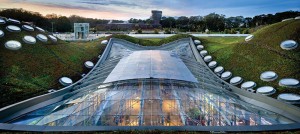The New Atrium Roof at the California Academy of Sciences Plays a Supporting Role to a Landmark Building
Walter P Moore was an Award Winner for the Atrium Operable Roof – California Academy of Sciences project in the 2012 NCSEA Annual Excellence in Structural Engineering awards program (Category – Other Structures).
When planning and designing the new operable roof at the California Academy of Sciences, the foremost concern was to allow the critically-acclaimed building to hold center stage while the new roof provided weather protection and ventilation quietly and elegantly in the background.
Designed by world-renowned architect Renzo Piano, the California Academy of Sciences opened in 2008 to wide acclaim as the largest LEED® Platinum building in the world and an architectural landmark for the City of San Francisco. Built as part of an ongoing revitalization of Golden Gate Park, the 412,000-square-foot Academy is a single structure containing multiple venues including an aquarium, planetarium, natural history museum, and four-story rainforest.
The Piazza – a glass-covered central atrium – serves as a multi-function gathering area for exhibit space, dining, and various community events. Furthering its function as a “living building” and taking full advantage of the pleasant northern California climate, the museum commissioned Walter P Moore to design a durable, high-performance operable roof over the Piazza that would allow open-air gatherings and maximize the amount of natural light entering the space. The original fixed Piazza glass roof that frames the opening is supported on a double-layer stainless steel rod net system spanning the 66-foot by 90-foot opening.
Working with such an iconic building required sensitivity as well as precise engineering to avoid altering the visitor’s experience of the space. Ari Harding, the Academy’s Director of Building Systems, described the process:
We were focused primarily on functionality and the idea that the new roof should fit in so well with the original architecture that the installation would be transparent to our guest experience. Given the difficult access and location, we had a fairly extensive list of performance criteria which needed to be met for a new roof to be considered.
Structural engineer Walter P Moore and mechanization contractor Uni-Systems conducted a thorough feasibility study to explore options for retrofitting the atrium roof for operability. Several factors influenced the eventual solution and shaped the design of the new Piazza roof, including:
- Existing Structure – The new roof had to be installed atop the existing double-layer stainless steel rod net structure without significant alterations to the existing structure and surrounding green roof.
- Continued Operation – The installation of the new roof could not cause significant disruption to building operations or functions.
- Aesthetics – The new roof had to integrate seamlessly with the existing architecture and visually reinforce the high-tech, progressive atmosphere.
- Sustainability – The new roof had to adhere to LEED measures already in place and could not create any situation or use of materials that would contradict the museum’s LEED Platinum certification.
- Operation and Maintenance – The new roof had to be designed for easy operation and maintenance while withstanding prevailing seismic and wind conditions.
In response, Walter P Moore designed a series of eight stainless steel arches, each spanning 64 feet across the existing glass roof and weighing approximately 2,250 pounds. Thrusts from these arches resolve into an existing perimeter truss designed to withstand tension from the cable-net system, effectively counteracting those forces. Stainless steel cables stabilize the arches and provide the framework for the translucent panels to be opened and closed quickly and quietly. The roof closing/opening time is 2 minutes and 45 seconds.
Two lightweight, stainless steel-framed panels, each 18 feet wide by 48 feet long, are carried by 24 high-strength, low-friction slide pad assemblies and driven by four belt drives which are fully concealed within the structural arches. The operable panels are clad with ½-inch thick, point-supported structural polycarbonate panels using a special formulation to provide for prolonged UV exposure. The unique use of point supports for the polycarbonate roofing sheets was supported through testing of prototype specimens by Uni-Systems.
For ease of maintenance and to combat corrosion, engineered plastics were used for all exposed wearing components of the drive system, eliminating the need for lubrication. Each high-strength reinforced polyurethane belt is driven by a 1-hp electric motor (roof total 8 hp), controlled by a variable-frequency drive. Roof movement is controlled from a single Programmable Logic Controller, integrated within an operator control touch screen that is linked to the Academy’s building management system to provide position feedback and allow for the roof to be operated remotely via iPad.
The final design is indeed transparent, integrating seamlessly with the existing fixed-glass roof and the surrounding 2.5-acre “living roof” as though it was part of the original design. From below, visitors don’t notice the addition. Except when it rains.▪

